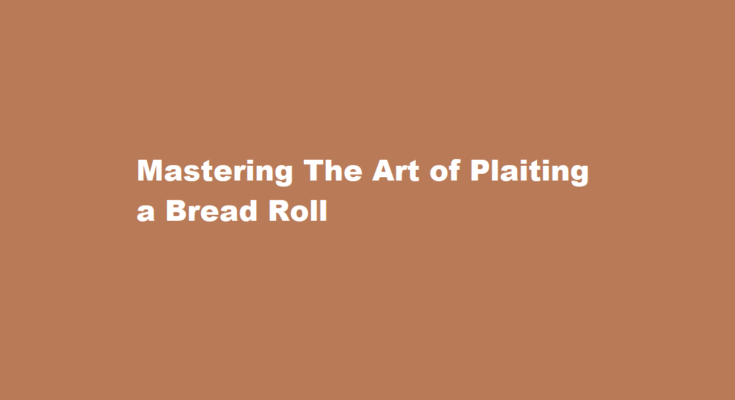Introduction
Baking is not just about creating delicious flavors; it’s also about the artistry and creativity that goes into making each dish. Plaited bread rolls, with their intricate and eye-catching designs, are a testament to the beauty that can be achieved in baking. In this article, we will guide you through the process of plaiting a bread roll, turning your ordinary bread into a work of art that will impress both your taste buds and your guests.
The Ingredients You’ll Need
Before we dive into the plating process, let’s gather the essential ingredients
1. Bread Dough You can use store-bought dough or prepare your own using flour, yeast, water, salt, and a touch of sugar.
2. Flour For dusting and rolling out the dough.
3. Filling (optional) You can use anything from sweet options like cinnamon sugar or savory choices like cheese and herbs.
4. Egg Wash A beaten egg mixed with a little water or milk for a shiny finish.
The Basic Steps
1. Prepare the Dough If you’re making your dough from scratch, follow your favorite bread recipe and let it rise until it has doubled in size.
2. Roll Out the Dough Flour your work surface, and using a rolling pin, roll out the dough into a rectangle. Aim for a thickness of about 1/4 inch.
3. Add the Filling (Optional) If you’re using a filling, spread it evenly over the rolled-out dough. Make sure not to overdo it, as too much filling can make the plating process tricky.
4. Cut the Dough Using a sharp knife or a pizza cutter, cut the dough into even strips. The number of strips will depend on how intricate you want your braid to be. For a basic three-strand braid, you can cut three equal strips.
Start Plaiting
a. Take the three strips and pinch them together at one end.
b. Cross the right strip over the middle strip.
c. Cross the left strip over the new middle strip (formerly the right strip).
d. Repeat these steps until you’ve reached the end of the strips. Pinch the ends together to seal.
- Shape the Roll Once you’ve plaited the dough, you can shape it into a circle or any other desired shape. Place it on a baking sheet lined with parchment paper.
- Let It Rise Cover the plaited roll with a clean kitchen towel and let it rise for about 30-45 minutes, or until it has puffed up noticeably.
- Preheat Your Oven Preheat your oven to the recommended temperature for your bread recipe (usually around 375-425°F or 190-220°C).
- Egg Wash Before baking, brush the plaited roll with the egg wash. This will give it a beautiful golden-brown finish.
- Bake Place the roll in the preheated oven and bake for the recommended time, which can vary depending on the size of your roll. Keep an eye on it, and remove it from the oven when it’s golden brown and sounds hollow when tapped on the bottom.
- Cool and Enjoy Allow the plaited bread roll to cool on a wire rack for a few minutes before slicing and serving. It’s best enjoyed fresh out of the oven.
Tips for Success
Practice Makes Perfect Plaiting can be a bit tricky at first, but don’t be discouraged if your first attempt isn’t perfect. With practice, your rolls will become more beautifully braided.
Experiment with Fillings While plain bread is delicious, don’t hesitate to get creative with fillings. Try things like Nutella and bananas for a sweet treat or spinach and feta for a savory option.
Precision Matters Cutting even strips and plaiting with care will result in a more visually appealing bread roll.
Use Quality Ingredients High-quality flour and fresh yeast can make a significant difference in the taste and texture of your bread.
Frequently Asked Questions
What is the most important step in bread making?
All steps in bread processing are important for a successful operation, but most bakers would agree that the three truly vital process steps are mixing, fermentation and baking.
What are the four pillars of bread?
In this episode of the Stella Culinary School Podcast we kick off our bread baking lecture series with a lesson on the four ingredients needed to make bread. We discuss the science behind flour, water, yeast and salt and how it will affect your overall bread dough recipe.
Conclusion
Plaiting a bread roll may seem like a daunting task, but with a little practice and patience, you can master this art form. The result is not only a delicious treat but also a stunning centerpiece for any meal or gathering. Whether you opt for a simple three-strand braid or a more intricate design, plaiting your bread roll adds a touch of elegance and creativity to your baking repertoire. So, roll up your sleeves, grab some dough, and start braiding your way to bread roll perfection. Your taste buds and guests will thank you for it!
Read Also : Braiding Bread Like a Viking Unraveling The Ancient Art



